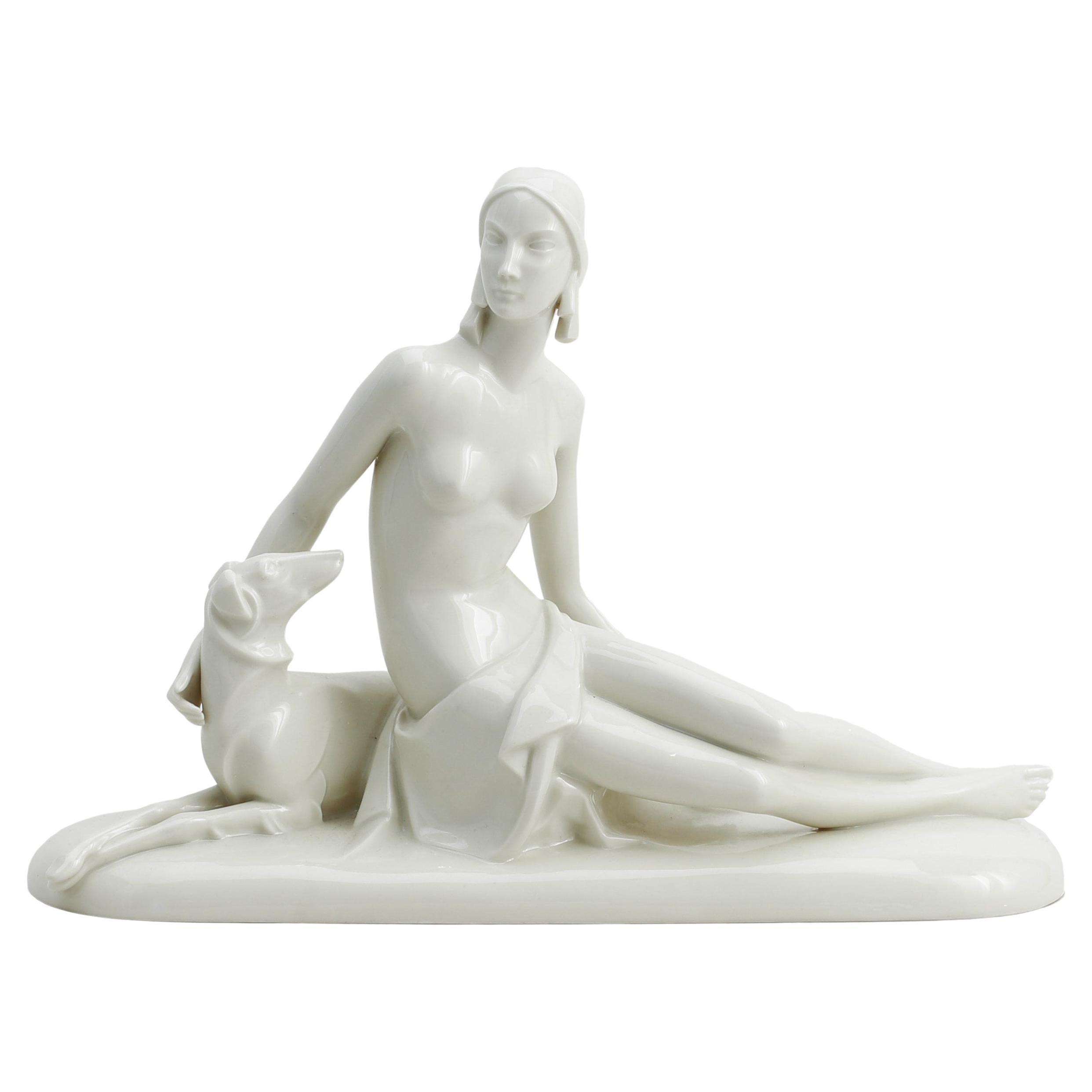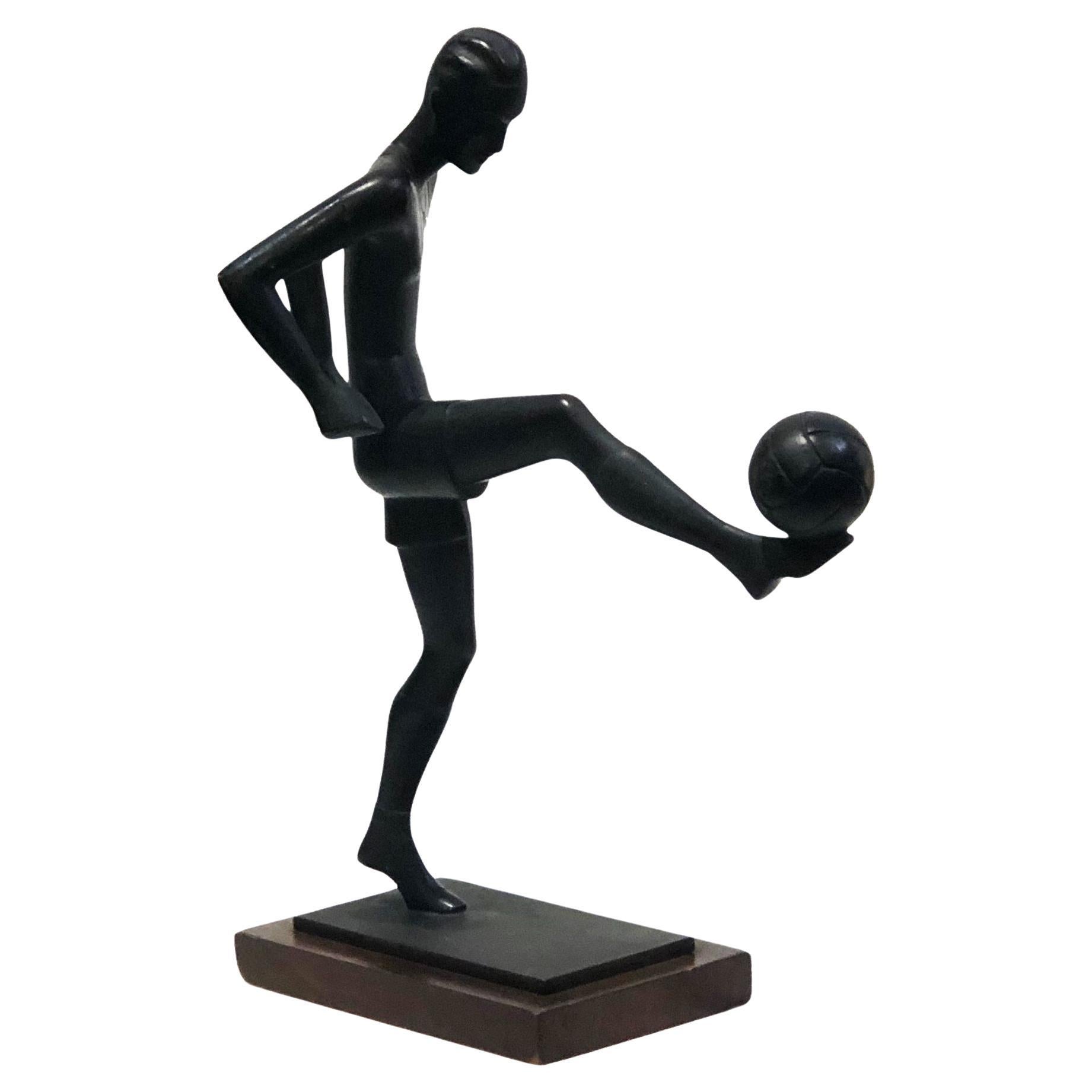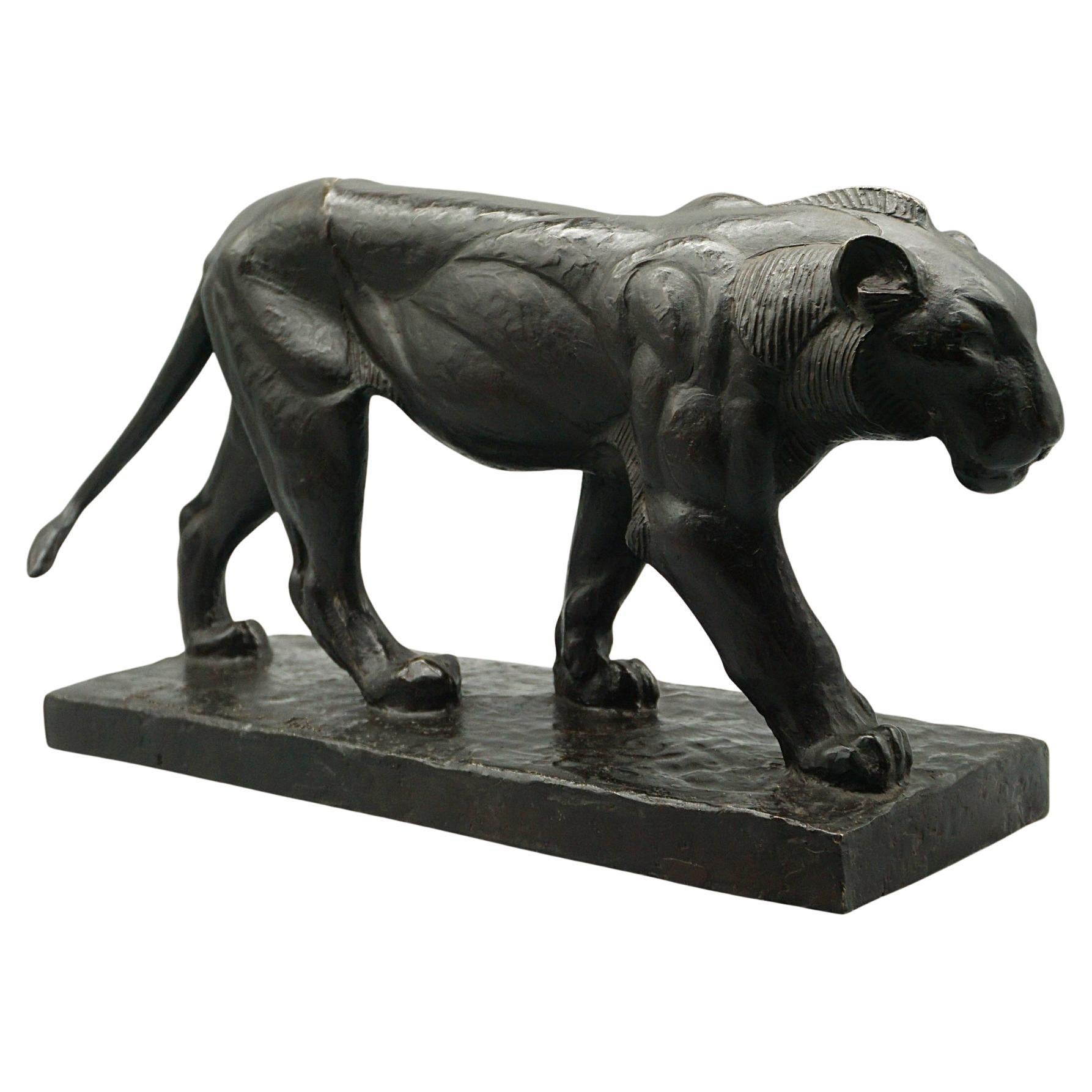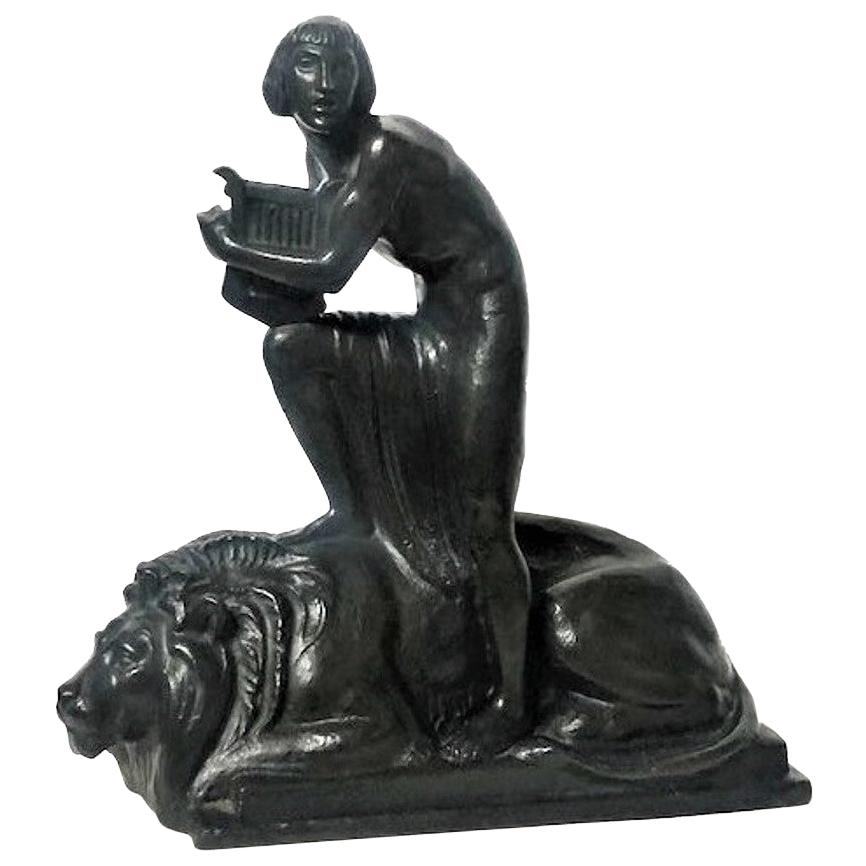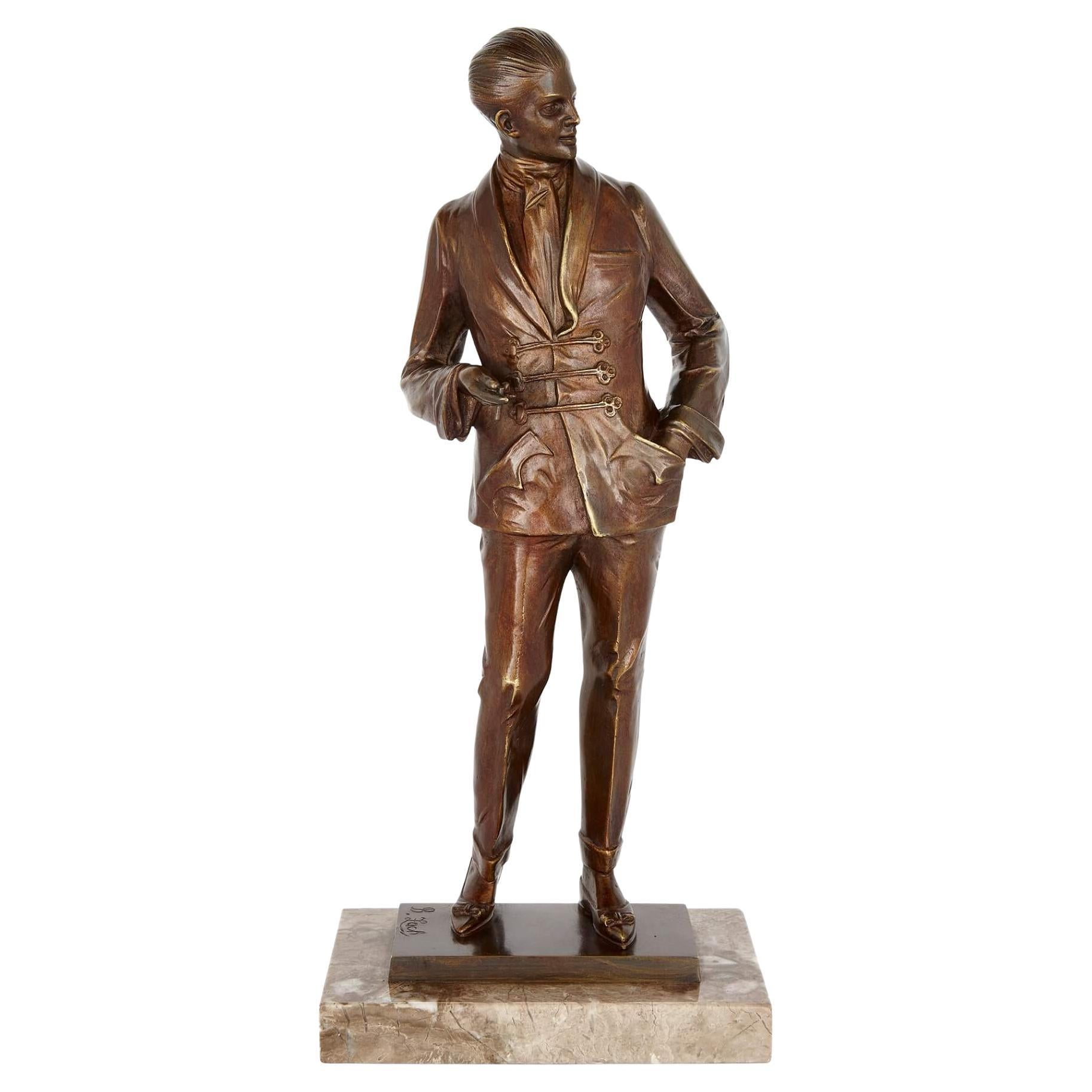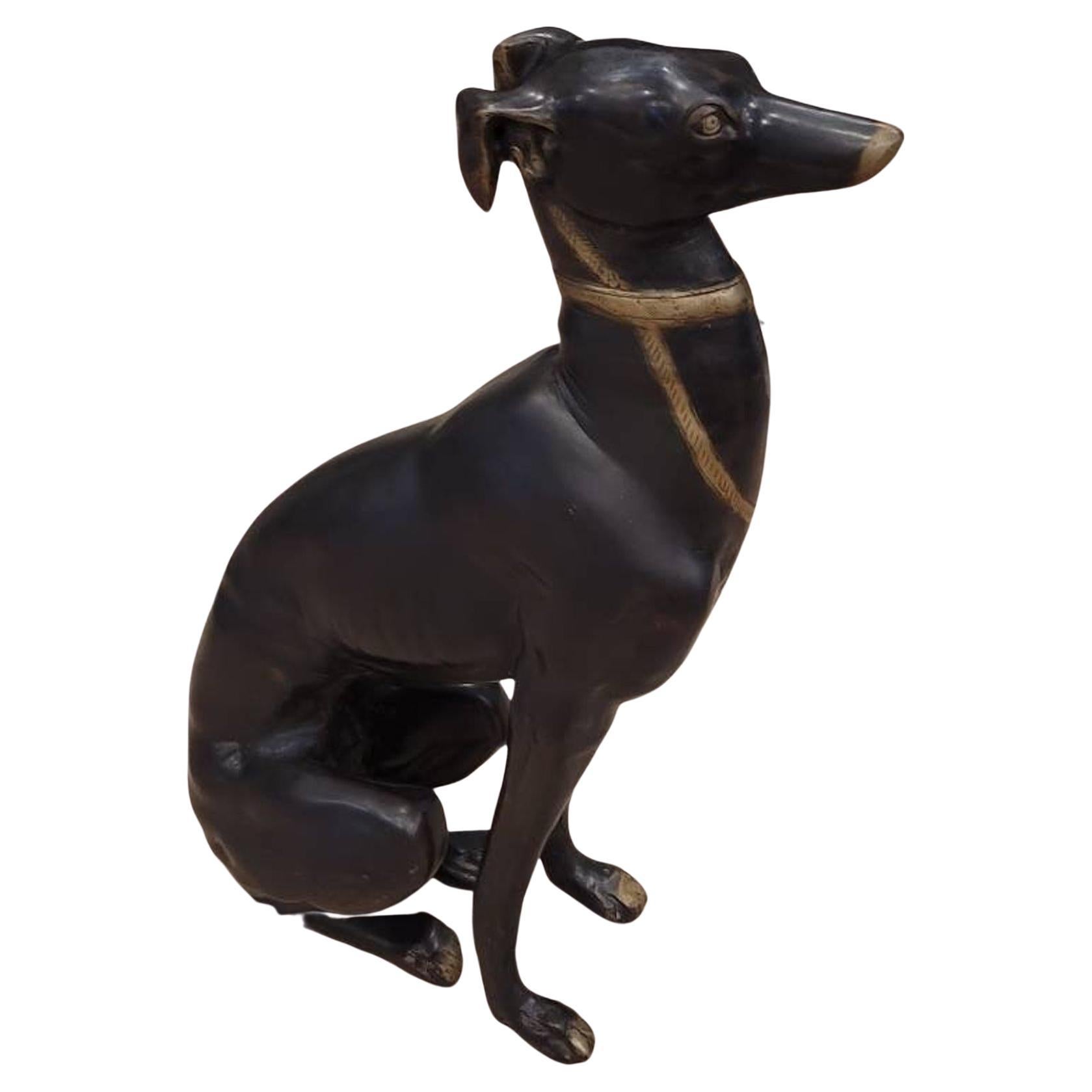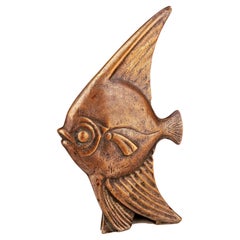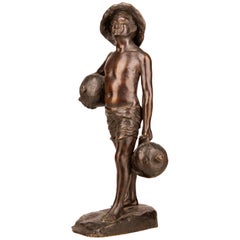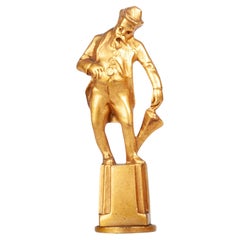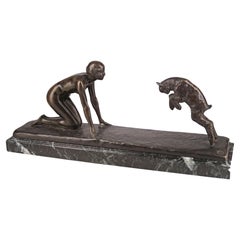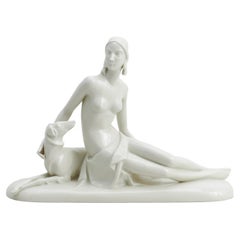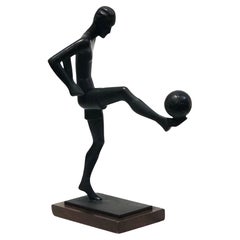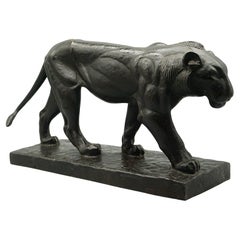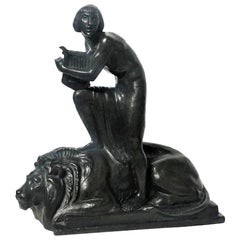Items Similar to Art Déco Patinated Bronze Sculpture of Duck by Gerhard Schliepstein, Germany
Want more images or videos?
Request additional images or videos from the seller
1 of 10
Art Déco Patinated Bronze Sculpture of Duck by Gerhard Schliepstein, Germany
$2,200
£1,662.93
€1,911
CA$3,063.49
A$3,408
CHF 1,786.52
MX$41,644.97
NOK 22,749.08
SEK 21,415.11
DKK 14,264.88
Shipping
Retrieving quote...The 1stDibs Promise:
Authenticity Guarantee,
Money-Back Guarantee,
24-Hour Cancellation
About the Item
Early 20th century Art Déco patinated bronze sculpture of duck with marble base by Gerhard Schliepstein, Germany
By: Gerhard Schliepstein
Material: bronze, copper, tin, metal, stone, marble
Technique: cast, molded, patinated, polished, metalwork
Dimensions: 4.5 in x 8.5 in
Date: early 20th century
Style: Art Déco, Jugendstil
Place of origin: Germany
With a softly stylized form and serene posture, this early 20th-century patinated bronze sculpture captures a duck with its neck gently curved toward its chest, rendered with precise attention to volume and anatomical rhythm. Resting on a dark, rounded marble base, the figure reveals a nuanced surface treatment—its metallic skin subtly modulated by a warm patina that deepens in recessed areas and edges, enhancing the sense of movement and depth.
Signed near the webbed feet, the composition combines Art Déco geometry with organic naturalism, displaying a fine balance between sculptural abstraction and lifelike charm. Made in Germany by Gerhard Schliepstein.
- Creator:Gerhard Schliepstein (Sculptor)
- Dimensions:Height: 8.5 in (21.59 cm)Diameter: 4.5 in (11.43 cm)
- Style:Art Deco (Of the Period)
- Materials and Techniques:
- Place of Origin:
- Period:
- Date of Manufacture:Early 20th Century
- Condition:Wear consistent with age and use.
- Seller Location:North Miami, FL
- Reference Number:1stDibs: LU8678245344402
About the Seller
5.0
Gold Seller
Premium sellers maintaining a 4.3+ rating and 24-hour response times
Established in 2011
1stDibs seller since 2023
46 sales on 1stDibs
Typical response time: 1 hour
- ShippingRetrieving quote...Shipping from: Buenos Aires, Argentina
- Return Policy
Authenticity Guarantee
In the unlikely event there’s an issue with an item’s authenticity, contact us within 1 year for a full refund. DetailsMoney-Back Guarantee
If your item is not as described, is damaged in transit, or does not arrive, contact us within 7 days for a full refund. Details24-Hour Cancellation
You have a 24-hour grace period in which to reconsider your purchase, with no questions asked.Vetted Professional Sellers
Our world-class sellers must adhere to strict standards for service and quality, maintaining the integrity of our listings.Price-Match Guarantee
If you find that a seller listed the same item for a lower price elsewhere, we’ll match it.Trusted Global Delivery
Our best-in-class carrier network provides specialized shipping options worldwide, including custom delivery.More From This Seller
View AllEarly 20th Century Art Déco French Patinated Bronze Sculpture of an Angel Fish
Located in North Miami, FL
Early 20th century Art Déco french patinated bronze sculpture of an angel fish
By: unknown
Material: bronze, copper, metal
Technique: cast, patinated, molded, metalwork
Dimensions: ...
Category
Early 20th Century French Art Deco Animal Sculptures
Materials
Bronze, Metal, Copper
Patinated Bronze Sculpture of Boy Holding Jugs Signed by Italian G. Borriello
Located in North Miami, FL
Patinated bronze sculpture of boy holding jugs signed by italian G. Borriello
By: G. Borriello
Material: copper, bronze, metal
Technique: cast, molded, patinated, metalwork
Dimensio...
Category
Antique Late 19th Century Italian Belle Époque Figurative Sculptures
Materials
Metal, Bronze, Copper
Art Déco Golden Bronze Small Sculpture/Figurine Seal of a Gentleman, England
Located in North Miami, FL
Early 20th century Art Déco golden bronze small sculpture/figurine seal of a gentleman, England
By: unknown
Material: bronze, copper, metal
Technique: cast, molded, metalwork, patinated, polished, gilt
Dimensions: 1 in x 1 in x 3 in
Date: early 20th century
Style: Art Déco
Place of origin: England
Embodying the quintessential English gentleman, this early 20th-century Art Déco seal...
Category
Early 20th Century English Art Deco Figurative Sculptures
Materials
Metal, Bronze, Copper
Art Déco Bronze Sculpture of Girl and Goat by Paul Silvestre for Susse Frères
By Susse Freres, Paul Silvestre
Located in North Miami, FL
Art Déco patinated bronze sculpture of a girl and a jumping goat with marble base by Paul Silvestre for Susse Frères
By: Paul Silvestre, Susse Frères
Material: bronze, marble, coppe...
Category
Early 20th Century French Art Deco Figurative Sculptures
Materials
Marble, Metal, Bronze, Copper
Art Déco Silvered Bronze Rabbit Sculpture by Animalier Swiss Author E.M. Sandoz
By Susse Freres, Edouard-Marcel Sandoz
Located in North Miami, FL
Art Déco silvered/nickeled bronze rabbit sculpture designed by animalier swiss author Édouard-Marcel Sandoz to be manufactured by the french firm Susse Frères
By: Édouard-Marcel Sandoz, Susse Frères
Material: bronze, nickel, silver, metal
Technique: polished, silvered, hand-crafted, patinated, metalwork, cast
Dimensions: 2 in x 1.5 in x 2 in
Date: early 20th century, circa 1930
Style: Art Déco, Animalier
Place of origin: France
This small sculpture, crafted by hand in nickel-plated bronze, depicts a rabbit with ears bowed in a gesture of meekness, its form affixed atop a sturdy base of matching material. In this case, the signature of artist...
Category
Early 20th Century French Art Deco Animal Sculptures
Materials
Silver, Bronze, Nickel, Metal
Gerdago's 'Cosmic Dance': Art Déco Austrian Bronze Chryselephantine Sculpture
Located in North Miami, FL
Gerda Gerdago's 'Cosmic Dance': Art Déco austrian patinated bronze chryselephantine (ivory and gold) sculpture manufactured by Arthur Rubinstein
By: Gerda Gerdago
Material: bronze, ...
Category
Early 20th Century Austrian Art Deco Figurative Sculptures
Materials
Marble, Bronze
You May Also Like
Art Deco Sculpture by Gerhard Schliepstein for Rosenthal, Named "Diana"
By Gerhard Schliepstein, Rosenthal, Jacob & Co (J. Rosenthal & S. Jacob)
Located in Stockholm, SE
Art Deco sculpture by Gerhard Schliepstein for Rosenthal, "Diana" ca. 1933–1934. Porcelain, white, glazed. Base signed: G. Schliepstein (embossed). Marked: Manufacturer's mark (green...
Category
Vintage 1930s German Art Deco Figurative Sculptures
Materials
Porcelain
Soccer Player, German Art Deco Patinated Bronze Sculpture, ca. 1930’s
Located in New York, NY
Art Deco
Soccer Player
Patinated Bronze Sculpture
Germany, ca. 1930’s
DIMENSIONS
Height: 9.5 inches Width: 6.75 inches Depth: 2.75 inches
ABOUT
A rare, laconi...
Category
Vintage 1930s German Art Deco Figurative Sculptures
Materials
Bronze
Art Deco Patinated Bronze Sculpture of a Prowling Panther by Piero Palozzolo
By Piero Palazzolo
Located in Forest Row, East Sussex
A superb Art Deco bronze sculpture of a striding panther by Piero Palozzolo. Signed to bronze with foundry stamp to base.
Dimensions: H 29cm W 53cm D 18cm
Origin: French
Date: Ci...
Category
Early 20th Century French Art Deco Animal Sculptures
Materials
Bronze
Ernst Seger, David and Lion, German Art Deco Patinated Bronze Sculpture, c. 1920
By Ernst Seger
Located in New York, NY
Signed “E. Seger”.
Black patina.
Dimensions
Height: 8 inches (20cm)
Width: 7.5 inches (18.75cm)
Depth: 8.5 inches (21.25cm)
THE BIBLE STORY
Samuel 17:34-36
Originally, Saul would not allow David to fight Goliath (17:33). Saul’s reason was simply that Goliath would be stronger than David. David was young and he did not have the experience to fight such a capable enemy as Goliath. David was likely to die, and his death would benefit nobody.
Often people wrongly imagine that they are acting in faith (in other words, that they are trusting God). Really, they are acting in a foolish manner, as if the danger is not real. They are not trusting in God, but in their own thoughts, hopes and desires.
David’s reply to Saul shows us his attitudes. This reply explains clearly why David had offered to fight Goliath. In other words, it shows how David considered himself able to defeat Goliath.
Like many boys and young men in Israel, David had worked as a shepherd. That is, he looked after sheep. He was responsible to look after those sheep in every way. In particular, he had to protect them from wild animals.
Lions and bears are some of the fiercest large wild animals. They were common in Israel at the time of the Bible. They are much stronger than a man (see for example 1 Kings 13:24 and 2 Kings 2:24). Only the bravest and strongest men were able to kill a lion (Judges 14:5-6; 2 Samuel 23:20). However, David had killed both a lion and a bear. He had killed animals that were stronger than him.
David did not believe that the strongest man would win the fight. David had a close relationship with God; he was trusting God to rescue him (17:37). David was not pretending that there was no danger. However, God’s Holy Spirit was active in David’s life (16:13). By the power of his Holy Spirit, God had given David the faith (trust in God) to fight Goliath. Because David really was trusting God, there was no reason for him to be afraid of Goliath.
THE ARTIST
Ernst Seger (1865 1939), born in Neurode (Nowa Ruda, now Poland), studied sculpturing from 1884 at the Kunstschule in Breslau under Robert Härtel. From 1886 he worked in the Atelier of Christian Behrens, where he created the Eichendorff-Memorial for the Silezian City of Neisse. From 1893 to 1894 Seger stayed in Paris where he worked in the atelier of Auguste Rodin. However, Seger finally chose a ‘Jugenstill’ and a more ‘naturalistic’ or ‘Neuklassizismus’ style. His sculptures, modelled like the Greek antiques, were later greatly admired by the National Socialists.
At the end of 1894 Ernst Seger went back to Berlin, founded his own atelier and created the Kaiser Wilhelm I memorial for the Silesian City of Glatz. In 1897 Seger created the sculpture ‘Jugend’ (‘Youth’), which was displayed at the ‘Große Berliner Kunstausstellung’ in 1898, at the ‘Große Berliner Kunstausstellung’ in 1899, at the ‘Münchener Glaspalast Ausstellung’ in 1899 and at the ‘Münchener Glaspalast Ausstellung’ in 1908. As a sculptor Seger regarded this as his first relevant work, his breakthrough. A copy of the sculpture in bronze, 1.60 metres high, was placed in the ‘Scheitniger Park’ in Breslau (now Wroclaw). In 1898 Segers ‘Diana’, the Roman Goddess of the Hunt, the Moon and Childbirth, was unvealed in Park Szczytnicki, Breslau, Polen (earlier ‘Schneitniger Park’). Until 1945 the sculpture stayed in the Schneitniger Park, Breslau. This part of the park is still called ’Dianagarten’.
After the turn of the century the elegant female dancers and nudes by Seger gained great popularity. In 1905 Ernst Seger created -together with the sculptor Bernhard Sehring- the ‘Bismarck Brunnen’ (‘Bismarck Fountain’) in Breslau. This memorial-fountain (which still exists) represents the allegories ‘Kampf’ and ‘Sieg’ (‘Battle and Victory’). Seger’s ‘Verwundete Amazone’ (‘Wounded Amazon’), displayed at the Grosse Münchner Kunstausstellung in the Glaspalast in 1908, was placed in the garden of the ‘Kaufhauses Wertheim’ in Berlin. In the same year he was appointed as a professor. Seger’s marble sculpture ‘Kypris’, created in 1916, was placed in the Alten Nationalgalerie in Berlin. In 1925 the City of Berlin acquired his sculpture ‘Anbetung’ and placed it at the Johannaplatz. ‘Storchenbrunnen’ (‘Stork-fountain’), was placed in 1931 at the Adolf-Scheidt-Platz in Berlin. In 1935 the American newspaper publisher William Randolph Hearst bought Seger’s sleeping ‘Ganymede’.
During the Third Reich Ernst Seger was commissioned numerous Hitler busts...
Category
Vintage 1920s German Art Deco Figurative Sculptures
Materials
Bronze
Patinated Bronze Art Deco Figural Sculpture, Signed by Bruno Zach
By Bruno Zach
Located in London, GB
Patinated bronze Art Deco figural sculpture, signed by Bruno Zach
Austrian, Early 20th Century
Height 35cm, width 15cm, depth 10cm
This...
Category
Early 20th Century Austrian Art Deco Figurative Sculptures
Materials
Bronze
Life-Size Art Deco Patinated Bronze Greyhound Sculpture
Located in Forney, TX
A life size Art Deco patinated bronze figural dog sculpture, most likely Italian, early/mid-20th century.
Fine quality, exceptionally execute...
Category
Early 20th Century Art Deco Animal Sculptures
Materials
Bronze
